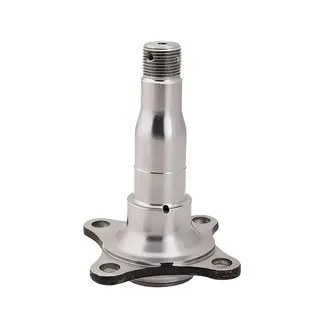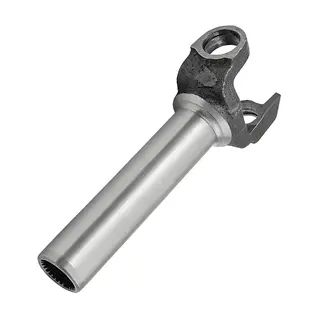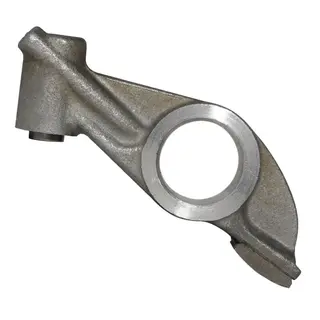In the forging industry, there is a seemingly trivial but extremely important process known as the de-scaling process. If you are not very familiar with forging, this process might sound unfamiliar. However, it actually has a profound impact on the quality, performance, and subsequent machining of forged parts. Today, let's delve deeper into the de-scaling process to understand its magic in significantly enhancing the quality and market competitiveness of forged parts.
First, we need to clarify what "phosphorus" refers to in this context. In the forging field, "phosphorus" does not refer to the chemical element phosphorus, but rather to the scale that forms on the surface of forged pieces after heating. This scale, which resembles fish scales and has a rough surface, is also vividly called "phosphorus skin." Just imagine, when a piece of metal is heated to a certain temperature, a hard, irregular layer forms on its surface, and this is the scale.
In simple terms, the de-scaling process is the removal of this layer of scale from the surface of the forged piece. Why is this necessary? Because this scale not only offers no benefits during the forging process but also brings many troubles. When the forged piece is struck, the scale can easily be pressed into the interior of the piece, like impurities mixed into meat, which degrades the quality of the forged piece. Therefore, to ensure the quality of the forged pieces, this layer of scale must be removed.
So, how exactly is the de-scaling process carried out? In modern forging production, the most commonly used method is high-pressure water de-scaling. In simple terms, this involves using a specialized forging de-scaling machine to treat the forged piece between heating and striking. This machine uses high-pressure water jets to impact the surface of the forged piece, removing the scale. This process is somewhat similar to using a high-pressure water gun to wash a car, except that the water pressure here is much greater, sufficient to strip off the hard scale.
High-pressure water de-scaling has many advantages. Firstly, it can efficiently remove the scale without causing damage to the forged piece itself. Secondly, this method is relatively environmentally friendly as it does not produce harmful chemicals. Most importantly, it can significantly improve the quality of the forged piece, making the subsequent forging process smoother.
The benefits of the de-scaling process for forged pieces are comprehensive, and we can understand them in detail from the following aspects:
Forging materials often contain impurities such as phosphorus, which can negatively affect the mechanical properties and corrosion resistance of the material. In steel, phosphorus exists in the form of iron phosphide, which degrades the welding performance of steel, reduces its plasticity and toughness, and makes it brittle at low temperatures. This means that the impact toughness of steel is significantly reduced at low temperatures. Through the de-scaling process, these impurities can be effectively removed, improving the purity of the material and thus enhancing its quality.
The forging process requires materials to have good machinability, but impurities such as phosphorus can reduce this property and lead to defects like cracks and porosity during machining. For example, in the forging process, if the material contains a high amount of phosphorus impurities, it may cause the forged piece to crack during shaping, affecting its integrity and quality. By removing phosphorus and other impurities, the machinability of the material can be improved, reducing defects during machining and ensuring the smooth shaping of forged pieces.
Impurities such as phosphorus can reduce the strength and toughness of the material, making forged pieces prone to breakage during use. For example, in mechanical parts that bear heavy loads, if the phosphorus content in the forged piece is too high, it may cause the part to break prematurely during use, affecting the normal operation of the equipment. By removing phosphorus and other impurities, the strength and toughness of the material can be increased, extending the service life of the forged piece and ensuring the safe and reliable operation of the equipment.
During the forging process, the material undergoes high temperatures and high stress, which can easily lead to phase transformations and fatigue. Impurities such as phosphorus can lower the phase transformation temperature of the material, increasing its thermal brittleness and fatigue sensitivity. For example, during post-forging heat treatment, if the material contains phosphorus impurities, it may cause abnormal phase transformations in the material, affecting the performance of the forged piece. By removing phosphorus and other impurities, the performance stability of the material can be improved, enhancing its resistance to thermal brittleness and fatigue, and ensuring the quality of the forged piece.
Without the de-scaling process, the hard scale can quickly damage the dies. When the scale is pressed into the forged piece during forging, it can cause surface defects such as pits, severely affecting the quality of the forged piece and even rendering it scrap. Additionally, it can reduce the service life of the dies. By removing the scale through the de-scaling process, die wear can be reduced, extending their service life and lowering production costs.
The scale on the surface of the forged piece can affect the effectiveness of subsequent machining processes, such as painting and electroplating. By removing the scale through the de-scaling process, the surface of the forged piece becomes smoother and flatter, improving the quality and efficiency of subsequent machining. For example, during painting, a smooth surface on the forged piece allows the paint to adhere better, enhancing the adhesion and corrosion resistance of the coating.
The de-scaling process not only improves the quality of forged pieces but also has a significant impact on production efficiency and costs.
Because the scale is hard, and in some cases even harder than ceramic, if it is not removed before forging, it can be rolled into the surface of the forged piece, creating pits of varying depths and a highly uneven surface. To ensure subsequent machining, a larger allowance must be reserved to ensure that a qualified machined surface is exposed. By using the de-scaling process, the machining allowance for subsequent processes can be reduced, improving the production efficiency of the factory.
The hardness of some scales is high and unevenly distributed, causing faster wear on the dies, which are also very costly to manufacture. By removing the scale through the de-scaling process, the damage to the dies is reduced, lowering die wear and thus reducing production costs.
Hot forging is a common metalworking method. It involves heating the forged piece and then using forging machinery to apply pressure to the blank, causing it to undergo plastic deformation to obtain a forged piece with certain mechanical properties, shape, and dimensions. The issue of scale has always been a research topic in the forging industry. By using the de-scaling process, this problem can be effectively solved, improving the quality and production efficiency of the forged pieces.
During hot forging, using high-pressure water de-scaling is a very effective method. The high-pressure water de-scaling system can precisely control the pressure and direction of the water jet, ensuring thorough removal of the scale. This de-scaling method is not only efficient but also environmentally friendly, meeting the environmental requirements of modern industrial production.
By de-scaling the steel billet with high-pressure water before the forging process, the amount of scale can be significantly reduced, thereby improving the surface quality of the forged piece. A smooth surface is not only aesthetically pleasing but also improves the quality and efficiency of subsequent machining. For example, in subsequent processes such as painting and electroplating, a high-quality surface can better adhere to the paint or plating layer, improving the product's corrosion resistance and service life.
The de-scaling process plays an indispensable role in the forging industry. It not only improves the quality and performance of forged pieces but also enhances production efficiency and reduces production costs. By removing the scale, we can obtain purer, tougher, and more durable forged pieces, thereby gaining a competitive edge in the fierce market competition. As forging technology continues to develop, the de-scaling process is also constantly being optimized and innovated. It is believed that in the future, it will play an even greater role in the forging industry and make a greater contribution to the development of manufacturing.
In summary, the de-scaling process is the quality guardian of the forging industry. By removing the scale, it makes forged pieces more perfect. Whether considering quality, performance, or cost-effectiveness, the de-scaling process deserves our high attention and widespread application. It is hoped that this article will give you a deeper understanding of the de-scaling process and provide some valuable references for practitioners in the forging industry.



